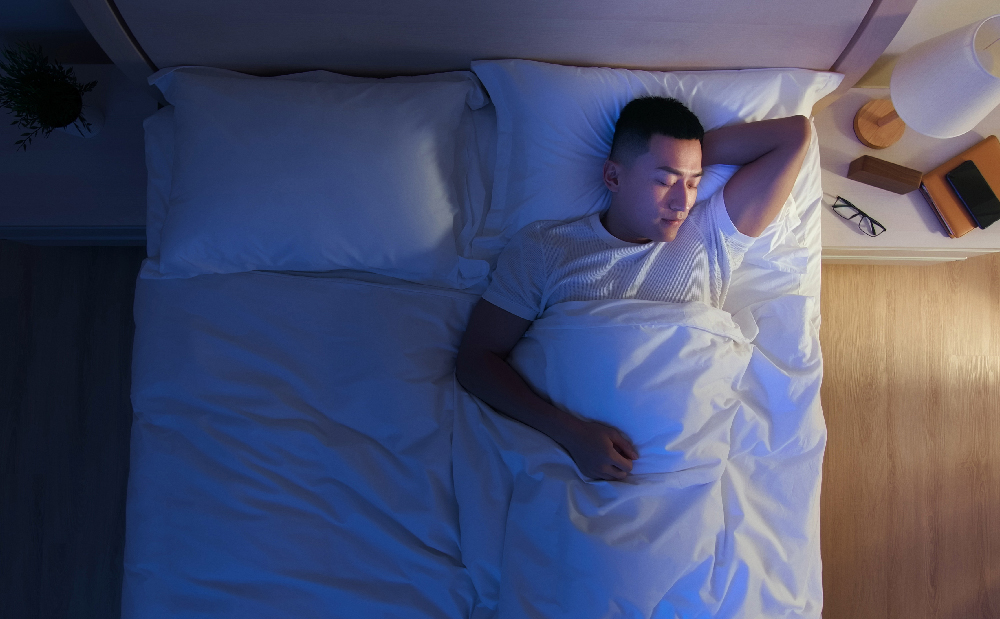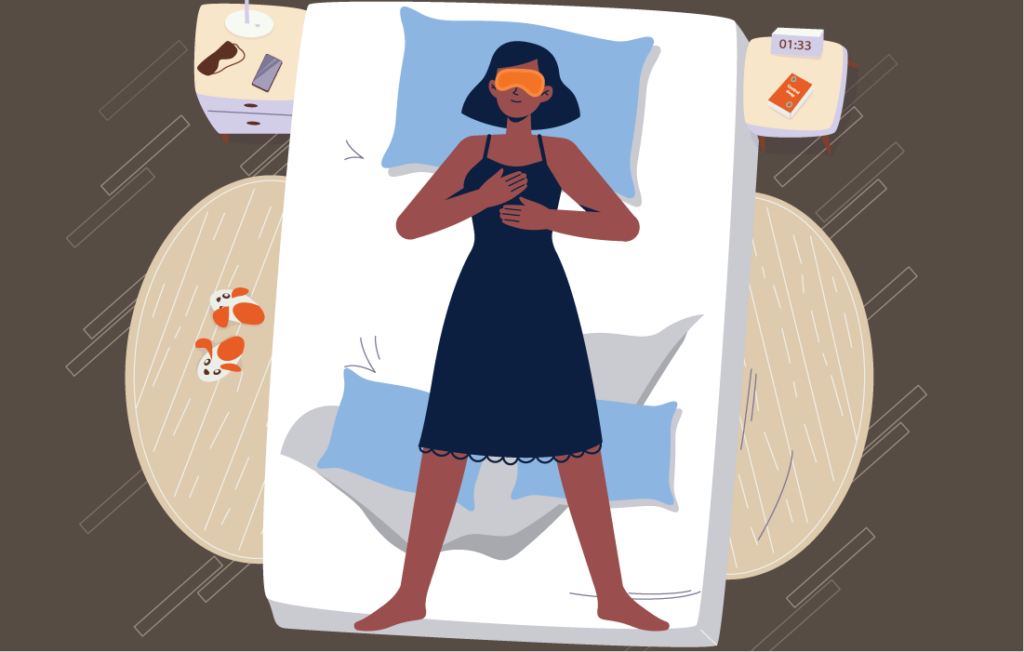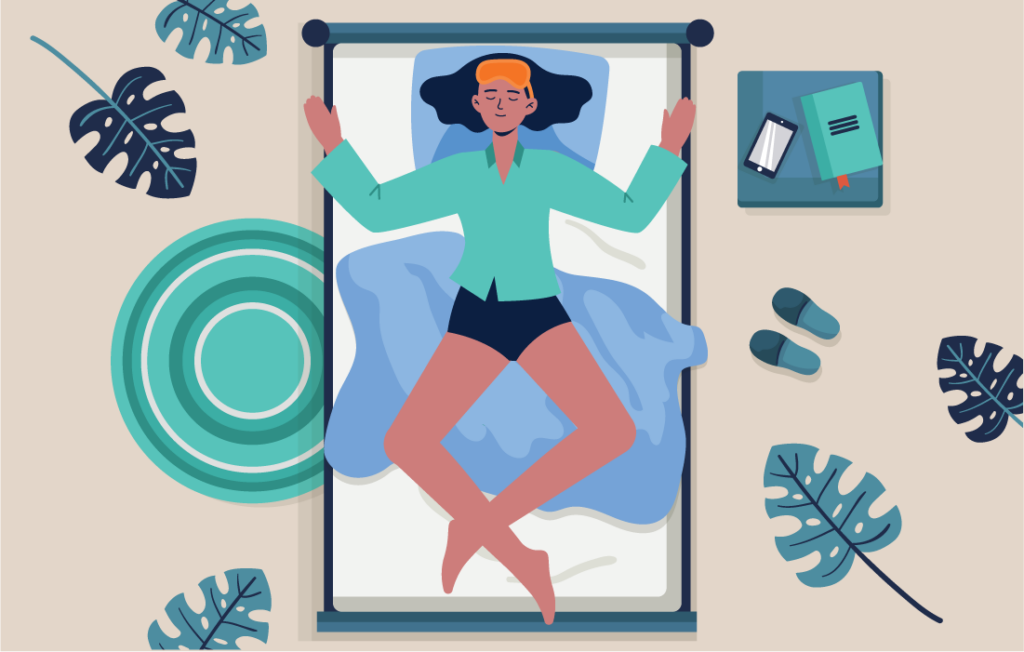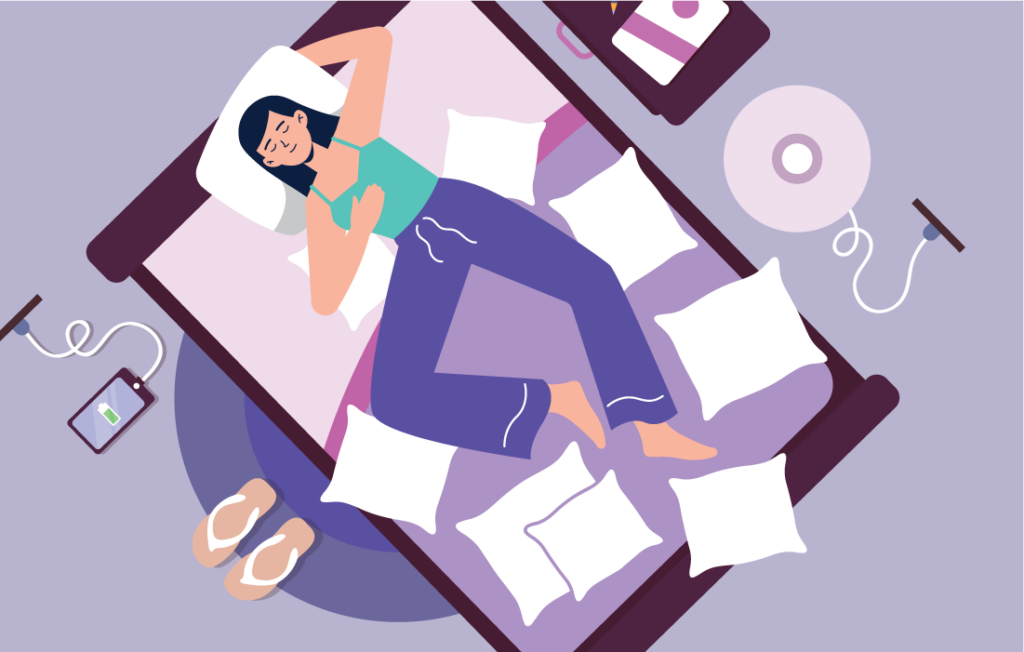
When you finally reach the end of a long day and collapse into your bed, you’re probably not thinking about how your sleeping position may affect your health — you just want to rest. However, the position you spend most of your time sleeping in can determine how rested you feel in the morning, including whether you wake up with a sore neck or shoulder.
Everyone has their preferred sleeping position. According to experts, we may benefit the most from sleeping on our backs, but doing so might not be the preferred position as we get older. (1) (2) Not a back sleeper? We’ve gathered some guidance for how to train yourself to sleep on your back.
Note: The content on Sleepopolis is meant to be informative in nature, but it shouldn’t be taken as medical advice, and it shouldn’t take the place of medical advice and supervision from a trained professional. If you feel you may be suffering from any sleep disorder or medical condition, please see your healthcare provider immediately.
Long Story Short
- While getting adequate quality sleep matters the most, many sleep experts say sleeping on your back is the healthiest position — but this may not be the case for sleepers with certain medical conditions.
- Sleeping on your back can be good for skin health, chronic pain, tension headaches, spinal alignment, and more.
- It’s possible to train yourself to sleep on your back using techniques like building physical pillow boundaries, visualization, a weighted blanket, and sleeping on the right mattress, along with practicing good sleep hygiene habits.
How to Train Yourself to Sleep on Your Back: 10 Tips
Sleep is your body’s designated time for repair, rejuvenation, and rest. First and foremost, sleep researchers recommend that adults aim for at least 7 hours of quality sleep at night for optimal health. (3) But it turns out that getting said sleep while positioned on your back may be even better.
If you’re not used to sleeping on your back, you’re probably wondering how you can convince your body to want to slither into that position come bedtime. Can you do that? According to Rick Swartzburg, chiropractor and mattress designer, “You absolutely can train yourself to sleep on your back.”
Taking his advice, we dug into some of the best tricks to train yourself to sleep on your back.
1. Make Sure You Have the Right Mattress
With all the mattresses to choose from, it can be confusing to pick the right one for your needs (but, that’s what we’re here for!). While plush mattresses can cradle side sleepers well, a reasonably firm surface is best to support back sleepers without feeling like you’re sinking into your mattress. Take note of the type of mattress you currently have and its level of firmness when you lie on your back. If you don’t have a firmer mattress but aren’t looking to invest in a brand-new one, consider our list of the best mattress toppers for back pain.
“The postural advantages are only seen when you are using a firm enough mattress to support your back, or if you are using a mattress that has more support for your heavier hips to prevent the hammocking that leads to poor spinal alignment,” cautions Swartzburg.
In other words, a medium-firm mattress is good for back sleepers because it helps keep your spine in it’s natural alignment, possibly preventing unwanted pain in the morning. (4) Innerspring and latex mattresses are usually the best options for back sleepers, but you may want to try out some memory foam ones that are meant for back sleepers as well.
2. Get the Right Kinds of Pillows
If your mattress isn’t firm enough to support back sleeping, a pillow (or mattress topper) can improve it. On the other hand, if your mattress is already pretty firm, a supportive pillow may elevate your neck too much, potentially misaligning your spine and setting you up for a stiff morning.
A good pillow for back sleepers offers a medium loft or a pillow that allows you to add or remove filling to adjust the loft. Experiment with options that allow your head and neck to feel natural and comfortable. Sometimes, a simple rolled-up towel supporting your head and neck may actually work better than a pillow.
3. Place a Pillow Under Your Knees

Preston Benjamin, DC of Enhance Life Chiropractic says, “If lying on your back causes you low back and hip discomfort you can put a pillow under your knees to relieve that.” (This is why your massage therapist or esthetician puts a bolster under your knees when you’re face-up). (5) Doing so in your bed may also help prevent you from rolling out of a back sleeping position in the night.
4. Spread Out Your Arms and Legs

Just because you’re lying on your back doesn’t mean you need to sleep like you’re in a casket — AKA the “soldier” position. Anecdotally, some people find that spreading their arms and legs out can increase comfort.
In the “starfish” position, you add a slight bend to your arms to help relax them further. One study suggests that relaxing your limbs like this may help relieve certain pressure points, which can help prevent them from going numb. (6)
5. Build a Pillow Fort

Creating physical blocks in your bed can prevent your body from moving too much at night. We’re not talking about sleeping in a box or strapping a set of skis to your legs — if you need to remind your body of its boundaries, a pillow fort can help.
Simply add some pillows all around your body to serve as a gentle reminder not to flip over onto the side or stomach. If you have a body pillow, this can take up a bit more space.
Alternatively, you can place pillows under your arms. This helps keep your shoulders comfortably elevated and holds your body in place.
6. Consider a Weighted Blanket
Many people swear by using a weighted blanket to potentially help calm anxiety and increase feelings of comfort. (7) Doing so may also help hold your body in place, making it a little easier to stay sleeping on your back through the night.
7. Practice During the Day
We’re not saying you should take multiple naps during the day, as this may disrupt your sleep-wake schedule and make it harder to go to bed. However, you can spend some time getting your body used to lying on your back in preparation for bedtime.
For example, spend 10-15 minutes each day lying down while doing something relaxing, like listening to music or a podcast, meditating, reading a book, or watching TV. This may help make it easier for your body to find comfort in this position in your bed.
8. Use Relaxation Techniques to Your Advantage
We often save relaxation techniques to reduce stress and anxiety, but they may also help when training yourself to sleep on your back.
Practice relaxation techniques such as deep breathing or progressive muscle relaxation (where you tense up your body and then gradually and consciously relax it, piece by piece, from head to toe) before bed to help your body relax into the back-sleeping position. Visualization can also be helpful. Imagine yourself in a comfortable, restful state, lying on your back. (8)
9. Lean Into Good Sleep Hygiene Habits
Sleep hygiene refers to the practices and habits that promote consistent, restful, and quality sleep. It includes maintaining a regular sleep schedule, creating a comfortable sleep environment, and engaging in behaviors that support good sleep, such as avoiding caffeine and electronics before bedtime. (9)
Making good sleep hygiene a regular practice can help make it easier to fall asleep and stay asleep on your back. If you’re sleeping well, and not regularly interrupted, you’ll be more likely to remain in that sleeping position most of the night.
Here are some tips for improving the coziness of your bedroom:
- Hang blackout curtains over your windows if you need to block some of the daylight
- Get a white noise machine to help cut out disruptive noise pollution (10)
- Wear comfortable pajamas that don’t make you too cold or hot
- Dress your bed in cozy and lightweight layers for temperature control
- Consider ways to incorporate relaxing aesthetics, like neutrals, earthy greens, and tranquil blue colors
10. Be Patient With Yourself
Changing your sleep position isn’t something that’s going to happen overnight. It’s possible that you’ll find it to be uncomfortable at first if your body isn’t used to sleeping this way.
However, if you’re set on training yourself to sleep on your back, our best advice is to keep at it. Like any other habits, you’ll eventually break out of old positional sleeping habits and find it easier to stick to new ones.
Most habits take at least a few weeks of consistent practice to build, though everyone is different. Consistency is key and it’s important to be kind to yourself, listen to your body, and have patience.
The Benefits of Sleeping on Your Back
Sleeping on your back is often recommended by sleep experts due to its potential health benefits, but again, this depends on your body and if you have certain health conditions. This position can help maintain proper spinal alignment, alleviate various physical discomforts, to name a few. Here are several benefits of sleeping on your back that can contribute to a more restful and rejuvenating night’s sleep.
Encourages Spinal Alignment
Back sleeping promotes a natural, healthy posture, reducing your risk of waking up in the morning with stiffness, aches, and pains. Adding a small bolster pillow under your knees and ensuring you have the right pillow to support your head and neck and the right mattress firmness for spinal alignment is important (11).
According to chiropractor Gil Kentof, founder of Dr. Gil Center for Back, Neck, and Chronic Pain Relief, “Sleeping on your back adds benefits to overall spinal health. It allows the muscles in your spine to remain more relaxed and allows for better alignment of the neck, mid and lower back. Those who suffer from lower back pain often find it beneficial to put a pillow under the knees so that the knees are slightly bent while sleeping on the back.”
Lessens Chronic Pain and Inflammation
We’ve all woken up with aches and pains from time to time, but that’s the last thing you want to deal with if you’re already living with chronic pain.
Because back sleeping may help reduce pressure and compression on your spine, it can help with chronic pain conditions, such as hip pain or joint pain from arthritis. According to M.D. Vikram Tarugu of Detox of South Florida, your weight is uniformly dispersed when you sleep on your back. This places less tension on the pressure points.
Kentof adds, “The other benefit of sleeping on your back is that it reduces pressure on the hip joints and shoulders.” Sleeping on your back is more beneficial because “we often see patients develop hip bursitis or shoulder tendinitis from sleeping on the same side of their body for years,” Kentof says.
Relieves Sinus Build-up
Those who struggle with allergies or sinus pressure may find that sleeping on their back with an elevated head and neck helps them breathe more clearly. That’s because mucus tends to pool and accumulate in the sinuses at night, particularly when your head is laying flat (12).
In order to relieve this congestion, Tarugu recommends that folks sleep on a few pillows with the head elevated to maintain a position where your head is above the heart. He says, “That will reduce the pooling of blood flow in the nose. By contrast, lying flat allows the mucus to build up in your sinuses, where it can obstruct your nasal passages and disrupt sleep.”
Improves Skin Quality
Wait, sleeping on your back can support your skin health? Yes!
“The easiest way to prevent wrinkles in the face and neck is to sleep on your back because it prevents the skin from getting compressed by pillows and patterned sheets,” explains Lesley Reynolds, a celebrity columnist and skin health expert based in the UK. In fact, “sleep wrinkles” tend to form during side and stomach sleeping due to the skin being stretched, compressed, and tightened. (13) For this reason, many dermatologists recommend back sleeping.
Kemunto Mokaya, board-certified dermatologist, author, and international speaker based in Knoxville, TN, says that sleeping on your back may also reduce breakouts and skin irritation. “Sleeping on our backs allows us to reduce contact with germ-containing pillowcases,” Mokaya explains. “It leads to less facial skin irritation and breakouts because the skin is not exposed to all the dirt and germs that pillowcases absorb.”
Relieves Some Headaches
Sleeping on your back may also help with certain types of headaches, particularly tension headaches, by promoting proper alignment of your head, neck, and spine. (14) When you lie on your back with your head properly supported by a pillow, it helps keep the neck in a neutral position, reducing strain and tension in the neck and shoulder muscles.
This reduction in muscle tension can prevent the onset of tension headaches, which are often caused by muscle tension and poor posture during sleep. (15)
Drawbacks to Sleeping on Your Back
While there are many practical benefits to sleeping on your back, it’s not automatically the best way to sleep for everyone. For some, sleeping on their back may even have potential downsides.
For instance, this position can be dangerous for people who have untreated obstructive sleep apnea. This is because gravity can cause the tongue and soft tissues in the throat to collapse backward, obstructing the airway further. (16)
However, this advice likely changes if you use a Positive Air Pressure (PAP) device to manage sleep apnea. In this case, sleeping on your back may be okay and more comfortable.
Sleeping flat on your back may also exacerbate snoring. In addition to bothering your bedmate, this can sometimes mean your sleep isn’t as sound or uninterrupted as it may be in another position, like your side — or at least, with an inclined pillow under your head. (17)
Next, if you have certain back conditions or chronic pain, sleeping on your back may be uncomfortable to the degree that it’s not worth continuing. It may also amplify lower back pain without proper support.
Finally, back sleeping can contribute to acid reflux, as lying flat can allow stomach acid to travel back up the esophagus more easily. (18)
If you have any of these issues, training yourself to sleep on your back may not be the best pursuit. If it doesn’t feel good to you, it may not be worth continuing. Consider speaking with your healthcare provider or a chiropractor regarding the best sleeping position for your needs.
When Not to Sleep on Your Back
There are specific situations when sleeping on your back might not be advisable. As mentioned, back sleeping can exacerbate conditions like sleep apnea and acid reflux.
In the case of acid reflux, sometimes you can continue training yourself to sleep on your back but with the addition of a wedge-shaped pillow. This supports your head and neck while angling your esophagus to prevent acid regurgitation. Alternatively, some studies suggest that the left lateral decubitus position (left side down, right side up) is best for minimizing acid reflux at night. (19)
People who are pregnant, particularly in the later stages of pregnancy (when things are getting extra uncomfortable!), are often advised against back sleeping. This is because it can compress major blood vessels and reduce blood flow to the fetus, potentially increasing the risk of stillbirth in some pregnancies. (20) (21) Instead, a body pillow for supported side sleeping can be safer and more comfortable.
Additionally, people who experience chronic lower back pain might find that back sleeping increases their discomfort unless proper support is used. If this is the case, it’s best not to force a position that doesn’t feel good and worsens existing pain.
FAQs
How long does it take to train yourself to sleep on your back?
Training yourself to sleep on your back can take a few weeks to a couple of months, depending on individual habits and consistency. Using supportive pillows and practicing good sleep hygiene can help accelerate the process. Persistence and gradually increasing the time spent in the desired position are key.
Do models sleep on their backs?
Some models prefer to sleep on their backs because of its potential benefits for preventing wrinkles and maintaining a youthful appearance. Sleeping in this position also avoids the pressure on the face that can come from side or stomach sleeping. However, we’re not aware of an official sleep guide for models, and not all models may adhere strictly to this practice.
The Last Word From Sleepopolis
We all have personal preferences when it comes to bedtime, including the sleeping position we find most comfortable. Some people already sleep on their backs, reaping the benefits of doing so for their spinal alignment, skin health, and more. For those who aren’t natural back sleepers but aspire to be one, consider the tips above for how to train yourself to sleep on your back.
Sources
- Cary D, Briffa K, McKenna L. Identifying relationships between sleep posture and non-specific spinal symptoms in adults: A scoping review. BMJ Open. 2019;9(6):e027633. Published 2019 Jun 28. doi:10.1136/bmjopen-2018-027633
- Skarpsno ES, Mork PJ, Nilsen TIL, Holtermann A. Sleep positions and nocturnal body movements based on free-living accelerometer recordings: association with demographics, lifestyle, and insomnia symptoms. Nat Sci Sleep. 2017;9:267-275. Published 2017 Nov 1. doi:10.2147/NSS.S145777
- FastStats: Sleep in Adults. Centers for Disease Control and Prevention. Retrieved from https://www.cdc.gov/sleep/data-research/facts-stats/adults-sleep-facts-and-stats.html
- Caggiari G, Talesa GR, Toro G, Jannelli E, Monteleone G, Puddu L. What type of mattress should be chosen to avoid back pain and improve sleep quality? Review of the literature. J Orthop Traumatol. 2021;22(1):51. Published 2021 Dec 8. doi:10.1186/s10195-021-00616-5
- Furlan AD, Giraldo M, Baskwill A, Irvin E, Imamura M. Massage for low-back pain. Cochrane Database Syst Rev. 2015;2015(9):CD001929. Published 2015 Sep 1. doi:10.1002/14651858.CD001929.pub3
- Roth Bettlach CL, Hasak JM, Krauss EM, et al. Preferences in Sleep Position Correlate With Nighttime Paresthesias in Healthy People Without Carpal Tunnel Syndrome. Hand (N Y). 2019;14(2):163-171. doi:10.1177/1558944717735942
- Yu J, Yang Z, Sun S, et al. The effect of weighted blankets on sleep and related disorders: a brief review. Front Psychiatry. 2024;15:1333015. Published 2024 Apr 15. doi:10.3389/fpsyt.2024.1333015
- Toussaint L, Nguyen QA, Roettger C, et al. Effectiveness of Progressive Muscle Relaxation, Deep Breathing, and Guided Imagery in Promoting Psychological and Physiological States of Relaxation. Evid Based Complement Alternat Med. 2021;2021:5924040. Published 2021 Jul 2. doi:10.1155/2021/5924040
- Baranwal N, Yu PK, Siegel NS. Sleep physiology, pathophysiology, and sleep hygiene. Prog Cardiovasc Dis. 2023;77:59-69. doi:10.1016/j.pcad.2023.02.005
- Ebben MR, Yan P, Krieger AC. The effects of white noise on sleep and duration in individuals living in a high noise environment in New York City. Sleep Med. 2021;83:256-259. doi:10.1016/j.sleep.2021.03.031
- University of Rochester Medical Center. Good Sleeping Posture Helps Your Back. Retrieved from https://www.urmc.rochester.edu/encyclopedia/content.aspx?ContentTypeID=1&ContentID=4460
- New York Sinus Center. How to Get a Good Night’s Sleep with Sinusitis. Retrieved from https://www.nysinuscenter.com/2021/02/sleep-with-sinusitis/
- Japatti S, Kumar J, Merchant AF, Dhalwale GD, Taneja P, Mathew RA. Association of Facial Wrinkles With Different Facial Forms in the Population of Maharashtra: A Prospective Observational Study. Cureus. 2023;15(10):e47692. Published 2023 Oct 25. doi:10.7759/cureus.47692
- Korabelnikova EA, Danilov AB, Danilov AB, Vorobyeva YD, Latysheva NV, Artemenko AR. Sleep Disorders and Headache: A Review of Correlation and Mutual Influence. Pain Ther. 2020;9(2):411-425. doi:10.1007/s40122-020-00180-6
- Cho SJ, Song TJ, Chu MK. Sleep and Tension-Type Headache. Curr Neurol Neurosci Rep. 2019;19(7):44. Published 2019 May 30. doi:10.1007/s11910-019-0953-8
- Platon AL, Stelea CG, Boișteanu O, et al. An Update on Obstructive Sleep Apnea Syndrome-A Literature Review. Medicina (Kaunas). 2023;59(8):1459. Published 2023 Aug 13. doi:10.3390/medicina59081459
- Danoff-Burg S, Rus HM, Weaver MA, Raymann RJEM. Sleeping in an Inclined Position to Reduce Snoring and Improve Sleep: In-home Product Intervention Study. JMIR Form Res. 2022;6(4):e30102. Published 2022 Apr 6. doi:10.2196/30102
- Schuitenmaker JM, van Dijk M, Oude Nijhuis RAB, Smout AJPM, Bredenoord AJ. Associations Between Sleep Position and Nocturnal Gastroesophageal Reflux: A Study Using Concurrent Monitoring of Sleep Position and Esophageal pH and Impedance. Am J Gastroenterol. 2022;117(2):346-351. doi:10.14309/ajg.0000000000001588
- Heazell A, Li M, Budd J, et al. Association between maternal sleep practices and late stillbirth – findings from a stillbirth case-control study. BJOG. 2018;125(2):254-262. doi:10.1111/1471-0528.14967
- National Guideline Alliance (UK). Maternal sleep position during pregnancy: Antenatal care. London: National Institute for Health and Care Excellence (NICE); August 2021.
Swartzburg, Rick. Personal interview. June 14, 2023.
Kentof, Gil. Personal interview. June 14, 2023.
Tarugu, Vikram. Personal interview. June 14, 2023.
Reynolds, Lesley. Personal interview. June 14, 2023.
Mokaya, Kemunto. Personal interview. June 14, 2023.
Benjamin, Preston. Personal interview. June 17, 2024.




























